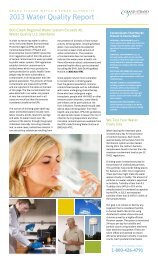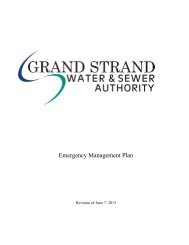GRAND STRAND WATER and SEWER AUTHORITY ...
GRAND STRAND WATER and SEWER AUTHORITY ...
GRAND STRAND WATER and SEWER AUTHORITY ...
You also want an ePaper? Increase the reach of your titles
YUMPU automatically turns print PDFs into web optimized ePapers that Google loves.
<strong>GRAND</strong> <strong>STRAND</strong> <strong>WATER</strong> <strong>and</strong> <strong>SEWER</strong> <strong>AUTHORITY</strong><br />
WASTE<strong>WATER</strong> TREATMENT FACILITY<br />
COMPOST<br />
3220 MR. JOE WHITE AVE.<br />
MYRTLE BEACH, S.C. 29577<br />
843-234-8425<br />
A product of the Gr<strong>and</strong> Str<strong>and</strong> Water <strong>and</strong> Sewer Authority (GSWSA), Myrtle Beach Wastewater Treatment Facility. Made<br />
from treated sewage sludge <strong>and</strong> wood chips. Sewage sludge when composted is a valuable resource that can be used to<br />
improve plant growth <strong>and</strong> soil quality. Nutrients in composted sewage sludge can replace or supplement commercial chemical<br />
fertilizers. In addition, the organic matter in compost improves soil structure <strong>and</strong> facilitates the ability of plants to acquire<br />
nutrients, retain water, <strong>and</strong> penetrate soil. These properties stimulate the growth of vegetation, which helps reduce soil erosion<br />
<strong>and</strong> improve crop yields. When h<strong>and</strong>ling compost or any other commercial potting soil/fertilizer, use sanitary methods <strong>and</strong><br />
keep out of children’s reach. Compliance with these instructions for use complies with section (e) of the Clean Water Act.<br />
Application of this product is prohibited except in accordance with the instructions on this information sheet.<br />
The most recent sludge analysis complied with all regulatory requirements of the parameters listed in Table 3, Page 9392 of the<br />
Friday, February 19, 1993 Federal Register.<br />
RECOMMENDED APPLICATION RATES (NON-AGRICULTURAL USE)<br />
Turfgrass: (rate per 1000 ft.)<br />
Establishment: 3 - 6 yards of compost tilled into top 4 - 6 inches of soil. Three cubic yards equal a 1-inch cover.<br />
Top dressing after seeding: Spread uniform cover 1/3 to ¼ inch. Apply in spring <strong>and</strong> fall for cool season grasses.<br />
Ornamental Planting:<br />
Flower Beds (annual): Incorporate 2 – 3 inches of compost into top 4 – 6 inches of soil.<br />
Permanent <strong>and</strong> Established: Work ½ to 1 inch of compost around plantings in spring <strong>and</strong> fall.<br />
Individual Plantings: Mix one part compost with one or two parts of soil for use as a back fill in a hole.<br />
Surface Mulch: Spread up to 1-inch compost over planting bed area.<br />
RECOMMENDED APPLICATION RATES FOR AGRICULTURAL USE OR BULK SALES<br />
• Bulk Sales - Compost product that is not sold in a bag or other container.<br />
• Other Container - A bucket, box, carton, or a vehicle that has a load capacity of one metric ton (2205 Lbs.) or less (i.e.: A<br />
pick-up truck or trailer pulled by an automobile).<br />
Any bulk compost product applied to agricultural l<strong>and</strong>, a public contact site (i.e.: Public parks, ball fields, cemeteries, plant<br />
nurseries, turf farms, <strong>and</strong> golf courses), or a l<strong>and</strong> reclamation site shall be applied at a Whole Sludge Application Rate (WSAR)<br />
that is equal to or less than the agronomic rate for the crop grown (based on the nitrogen needs of the crop).<br />
Note: Most sewage sludge is low in Potassium <strong>and</strong> Potassium may need to be applied at an agronomic rate.<br />
The following Bulk l<strong>and</strong> application rates shall not be exceeded:<br />
1) AWSAR - 66.7 metric tons/hectare/year (29.75 tons/acre/year or @ 170.0 cubic yards of compost/acre/year)<br />
2) Annual Application Rate (based on the Nitrogen needs of the crop grown). See example below:<br />
EXAMPLE<br />
Nitrogen needs of crop grown (non-irrigated soybeans), or 240 Lbs./Acre/Year divided by 1.73 Lbs. of Nitrogen/Cubic Yard of<br />
Compost = 138.8 Cubic Yards/Acre/Year.<br />
Note: Actual Nitrogen Content may vary greatly <strong>and</strong> further analysis may need to be conducted to insure the Nitrogen needs of<br />
the crop are met <strong>and</strong> not exceeded. Contact your local Agriculture Extension Service agent for information on the Nitrogen<br />
needs of the crop.<br />
ANNUAL WHOLE SLUDGE APPLICATION RATE (AWSAR)
The AWSAR is determined solely by calculating the metals pollutant levels applied yearly to the site. The metal with the<br />
lowest site life will determine how many years compost can be applied until the pollutant (metals) ceiling concentration is met.<br />
See the formula below:<br />
AWSAR (Metric Tons/Hectare/Year) = APLR (from table 4 of 503.13)<br />
Pollutant Concentration (Mg/Kg) X 0.001<br />
SITE LIFE (Using the AWSAR & Agronomic rate for Soybeans from examples on previous page)<br />
EXAMPLE #1 - AWSAR site life is 20 years [assuming the full AWSAR (29.75 dry tons/acre/year) is applied each year]<br />
EXAMPLE #2 - Site Life based on Agronomic Rate for Crop (example - Soybeans) is 24.49. Assuming that 24.29 Dry<br />
Tons/acre/year or 138.8 cubic yards/acre/year is applied to the l<strong>and</strong> for 24.49 years, then the site life based on the agronomic<br />
rate will be reached.<br />
Therefore, since it is prohibited to apply compost at a rate greater than the agronomic rate, the Site Life for the above examples<br />
would be 24.49 years. If you have any concerns or questions on site life for the crop to be grown, please contact the GSWSA –<br />
Myrtle Beach Wastewater Treatment Facility Superintendent for answers.<br />
POLLUTANT METALS ANALYSIS (EPA 503.13 TABLE 3)<br />
The following pollutant metal concentrations are from the most recent quarterly compost analysis.<br />
PARAMETER RESULT UNIT DATE PARAMETER RESULT UNIT DATE<br />
Arsenic 5.2 mg/kg * 06/04/08 Cadmium 0.66 mg/kg * 06/04/08<br />
Copper 380 mg/kg * 06/04/08 Lead 17 mg/kg * 06/04/08<br />
Mercury 0. 82 mg/kg * 06/04/08 Nickel 26 mg/kg * 06/04/08<br />
Selenium 4.5 mg/kg * 06/04/08 Zinc 2100 mg/kg * 06/04/08<br />
Molybdenum 10 mg/kg * 06/04/08 * Dry Weight Basis<br />
NUTRIENT ANALYSIS<br />
The following nutrient analyses are from the most recently available results. These numbers may be six (6) months or greater in<br />
time since the last nutrient sampling event, for more accurate up to date information, an additional analysis should be conducted<br />
by the applier of this product at their own expense. Due to the fact that the nutrient content in sewage sludge can vary greatly<br />
from week to week, GSWSA cannot guarantee the nutrient levels in compost received by the customer.<br />
PARAMETER RESULT UNIT DATE PARAMETER RESULT UNIT DATE<br />
Potassium, Total 3200 mg/kg 06/10/08 Specific Conductance 1670 umhos 06/10/08<br />
Sodium, Total 710 mg/kg 06/10/08 Fecal (A-1)






